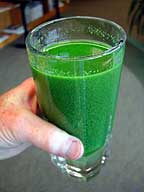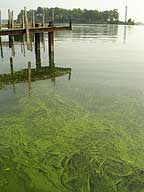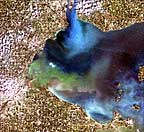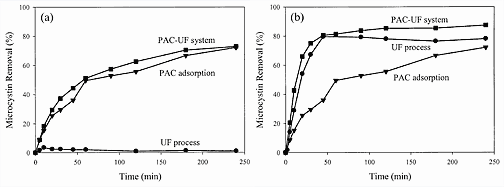 |
|||||||||
skip to content |
|||||||||
Something in the Water
Ohio Sea Grant Research Finds New Methods to Extract Toxins from Drinking Water

Microcystis, a form of blue-green algae which occurs in Lake Erie during the summer months, generate toxins that can be harmful to humans and animals. Photo: Tom Bridgeman, University of Toledo

Ohio Sea Grant researcher, Dr. Hal Walker, combines activated carbon and a ultrafiltration process to remove up to 95% of microcystin toxins in Lake Erie drinking water. Photo: Erin Quinlan, Ohio State University

Microcystis blooms like this one in August 2003 have occurred in Lake Erie every summer for the last 10 years.
Anyone visiting Lake Erie over the last few summers has seen it–that thick, green algae floating over large stretches of the lake's coastline. Although people aren't likely to lean over their boat, take a glassful, and drink it, many may not realize that they could be drinking small amounts of the toxins the alga produces in their daily water supply.
Microcystis, a form of blue-green algae which occur in Lake Erie during the warm summer months, generate toxins called microcystins that can be harmful to humans and animals. When consumed or in contact with skin, the potent toxins in the water can cause such health problems as nausea, liver damage, or in extreme cases, death. Because of these concerns, the World Health Organization has set safe drinking levels for the toxin and the USEPA has added it to its drinking water contaminant list.
But algal blooms have been growing larger and with more frequency in Lake Erie. Once considered to be controlled by nutrient limits, algal blooms are back, occurring every summer for the past ten years.
"With 13 million people relying on Lake Erie for two billion gallons of water annually, microcystin toxins in drinking water are a growing concern, " says Ohio Sea Grant researcher Dr. Hal Walker.
Over the last several years, Dr. Walker from Ohio State University has been looking into new ways to remove the toxins from drinking water.
The problem is water treatment facilities around Lake Erie may not specifically treat drinking water for the microcystins and many of the conventional removal processes are ineffective on them. "What we wanted to do was to find treatments that could be relatively easy to incorporate into water treatment facilities and still be effective to remove the toxin, " states Walker.
To do this, Walker experimented with different methods, combining several types of powdered activated carbon (PAC) with ultrafiltration.
"We knew that activated carbon worked to remove microcystin toxins–a process that is already used in some facilities for herbicide removal and taste and odor control, " explains Walker. "We wanted to see what type of PAC would be most effective, and if coupled with ultrafiltration, how much each method would remove. "
In a series of laboratory experiments, Walker and his graduate student, Julie Lee, tested two types of activated carbon and found that the wood-based activated carbon was up to four times more effective at removing microcystin than the coconut-based carbon.
By combining the activated carbon with an ultrafiltration process, Walker could remove nearly all of the microcystin toxin from the water. His polyethersulfone membrane removed 87% of the microcystin when coupled with wood-based PAC, while the cellulose acetate membrane removed 70%. But when he increased the amount of activated carbon used in the process, both filters removed more than 95% of the toxin.

By coupling wood-based activated carbon and a membrane ultraftilration system, Walker removed 87% of the microcystin from the drinking water (Figure B). Using the acetate membrane filter removed 70% (Figure A). However, increasing the dose of activated carbon resulted in more than 95% removal for both membrane filters (data not shown)
Walker found the amount of organic matter in the water, however, affected how much toxin is removed. The more organic mater, the less toxin was removed. To counter that, Walker's research suggests that water treatment facilities add more PAC to the treatment if higher levels of organic matter exist in the water.
However, adding one of Walker's filter membranes could help as well. "The use of ultrafiltration membranes like the membranes we examined could be a good way to separate activated carbon from the water, " concludes Walker. "Water treatment facilities could be even more cost effective by capturing the carbon and recycling it for more efficient microcystin removal. "
For more information about this Ohio Sea Grant funded project, contact Dr. Hal Walker at 614.292.8263 or walker.455@osu.edu.
|
Ohio Sea Grant works to increase understanding, assessment, utilization, development, conservation, and stewardship of our Great Lakes and ocean resources, with particular emphasis on Lake Erie. Using a combination of research, education, and outreach, Ohio Sea Grant partners with academia, government, and the private sector to focus on the economy, environment, and education. The Ohio Sea Grant College Program is one of 30 programs in the National Sea Grant College Program of the National Oceanic and Atmospheric Administration (NOAA), Department of Commerce. Ohio Sea Grant is supported by NOAA, the Ohio Board of Regents, The Ohio State University, industries, and associations. |
9/18/06
CLIMATE · OCEANS, GREAT LAKES, and COASTS · WEATHER
and AIR QUALITY
ABOUT US · RESEARCH
PROGRAMS · EDUCATION · HOME